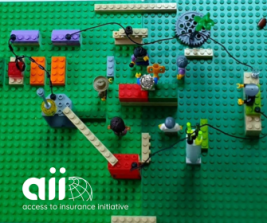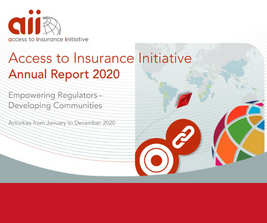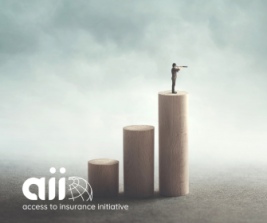Mainstreaming gender in inclusive insurance – the time is now!
Mainstreaming gender in inclusive insurance – the time is now!

On this International Women's Day, you would likely have read or heard it said that women represent the majority of uninsured in the world. This is widely accepted and is most likely the truth too. Though why do we say it's most likely the truth?
We say so because we don’t have the data. We don't have any comprehensive data set on women's access to insurance, both on demand or the supply. The development community - and insurance sector stakeholders - do not actively collect gender-disaggregated data. For example, for more than half of the products identified by the Microinsurance Network's Landscape of Microinsurance report for 2021, providers did not provide information on the proportion of women covered.
To put this into context, the International Finance Corporation (IFC) in 2015 predicted that by 2030 the insurance industry would earn USD 1.7 trillion from women alone. It does indeed seem contradictory that we have such low levels of gender-disaggregated data when women, especially those from the emerging markets, offer such a robust target market.
Apart from lack of gender-disaggregated data, A2ii's report on 'Role of Insurance Supervisors in Boosting Women's Access to Insurance’ identified other issues that set back women’s access to insurance. This study, made feasible by the support of the Swiss Agency for Development and Cooperation (SDC), identifies socio-economic challenges unique to women that hamper demand and supply, for instance:
- Women are less likely to have ID documents or asset ownership as compared to men
- Women are more likely to be hampered by restrictive cultural barriers, which makes it difficult for them to access male-dominated insurance points of sale or service, just as they are less likely to get credit for their businesses than men.
- The gender gap persists in the digital sphere as well. Women are less likely to have access to mobile phones and internet as compared to men and by extension, are less likely to access digitally delivered insurance solutions.
- On the supply side, women are underrepresented on insurance company boards and in C-suite roles and among their rank and file. This underrepresentation extends to insurance supervisors as well.
It is also now increasingly acknowledged that insurance regulation needs to move from being gender-neutral to being gender aware. In other words, all stakeholders must be deliberate in efforts to close the gender gap in access to insurance. Gendered considerations should not be an afterthought but a core pillar of inclusive insurance work.
Our Turn
At the A2ii, we work with insurance supervisors to build their capacity towards making insurance more inclusive. Hence, to be able to better support them in addressing the gender gap, we needed to mainstream gender within our organisation and learn from this experience. For A2ii, gender mainstreaming had to begin at home!
This idea found resonance with and support from the SDC which enabled us to embark on a comprehensive gender mainstreaming exercise.
Getting started
With the support of gender mainstreaming experts, we started with a gender audit of all of our work, from our vision and mission statements down to our workplan, knowledge products, training modules, policy dialogues, iii-lab, and even how our job descriptions have been written. This was followed by a discussion with all our team members, key stakeholders of A2ii, including insurance supervisors, representatives from the IAIS and our executive committee.
The gender mainstreaming audit exercise helped us identify the things we were doing right, where the gaps were and what all we can do to address them.
Making it tangible
If we were to leave gender mainstreaming as just an abstract idea, it would likely to have little cogency and consistency and hence less likely to be impactful. Three specific gender mainstreaming tools helped us substantiate the intent.
A2ii’s tools for mainstreaming gender
- A statement of intent – an explicit A2ii statement of intent on gender helps us answer: Why are we mainstreaming gender in our work, and how does it tie in with our mission? This gives us a clear goal to work towards.
- Cross-thematic ‘boilerplates’ – these boilerplates, or key messages, will articulate A2ii’s stance and view on gender issues across all topics in inclusive insurance, such as health insurance, climate risk insurance, digitalisation or remittances. Importantly, the process of developing these boilerplates will help the team identify, in a structured way, the challenges that exist in the thematic area and gaps in the information that we need while enabling us to critically analyse and define the gendered aspects of these challenges. This will bring greater focus on gender considerations and a solid factual grounding into our stance and activities.
- The assessment checklist – To ensure that all our outputs, knowledge products, advocacy and capacity building efforts include and integrate gender, we have developed a checklist. This checklist comprises a set of questions that we ask ourselves whenever we undertake any activity on our work plan. The questions are to ensure that we haven’t siloed gender in our work., The checklist will help us to ensure that we have brought forth the gendered aspects of the issues we are looking to address. It would prompt us to look for gender-disaggregated data when needed and highlight the availability or lack of such data, amongst other things. It also builds in checks to ensure we strive for optimal gender balance amongst our speakers, trainers and other stakeholders as feasible.
To pull it all together, we have drafted a gender action plan that identifies the different efforts we need to make, who the owners of these efforts are within our team, what the desired outcomes are, and the timelines to do so. The next level is now to ensure that we transfer these aspects into our activities and tools for insurance supervisors.
What supervisors can look forward to
More and more insurance supervisors from emerging market jurisdictions are gearing towards making gender a priority in their work. At the A2ii Public Dialogue on women’s access to insurance in 2021, the Financial Services Commission (FSC) of Mauritius shared how they integrate gender considerations in their internal policies and supervisory initiatives. For instance, women empowerment centres were set up for financial literacy programmes and outreach to women. The FSC notes that women are underrepresented in management roles in the insurance sector (50 per cent less than men) and overrepresented in technical and support roles (twice compared to men). Internally, however, 61 per cent of FSC staff are female, with 67 per cent of female staff being in managerial roles. FSC actively supports equal opportunities and training programmes for women internally.
To help supervisors along the same path, A2ii is currently developing a few tools to enable supervisors to self-assess where they stand in terms of gender maturity and subsequently identify the steps they can take:
- Firstly, A2ii has devised a gender maturity assessment tool. Think of it as a dipstick test that helps insurance supervisors realistically yet rapidly assess their gender maturity, i.e. how well is gender integrated into their regulatory and supervisory work, including their organisational make-up.
- The results from this toolkit can then be compared with A2ii’s gender maturity model for insurance supervisors, currently a work-in-progress. This is a model that helps regulators decode the findings of their gender maturity test by telling them if they are at the foundational level (i.e. are doing most of the basics right) or at the tactical level (i.e. basics are well covered and you are taking steps to make gender a major component of your initiatives) or at the strategic level (i.e. have an advanced level of gender maturity where gender is a strategic pillar of all your work, internal as well as external). The model will also help suggest the steps that insurance supervisors can take to progress from one level to the next, in the right direction. This also will help A2ii design the appropriate support for insurance supervisors.
- A2ii also is currently developing a ‘gender awareness in inclusive insurance’ training module for insurance supervisors. This module would build on toolkits by further informing and orientating supervisors on gender-aware insurance supervision and enable them with a set of tangible resources and tools that they may use to adopt gender-aware policies.
- Finally, A2ii is developing a template for collecting gender-disaggregated data in inclusive insurance for insurance supervisors. As a start, we have identified data items and key indicators that supervisors can collect to measure the contribution of their insurance sector to SDG 5 Gender Equality as part of the Supervisory KPIs Lexicon, including a case study in the accompanying handbook on collecting SDG 5 data.
The way ahead
The A2ii is just at the start of its gender mainstreaming journey. Yes, we have our plans in place and our tools at hand, but now comes the moment of truth, the time to put them to use, every single day, in all our work, actively and consistently. We look forward to the day when we would no longer have to reach for our tools because ‘gender awareness’ is simply the default for A2ii and insurance supervisors.
On this International Women’s Day, we share our gender mainstreaming journey and reiterate our commitment to work with our stakeholders across the inclusive insurance spectrum to embrace gender mainstreaming. We aspire that in years from now, perhaps on another International Women’s Day, when we reflect upon women’s access to insurance, we see more women in leadership roles at insurance supervisors and in the insurance industry. We aspire to see gender considerations becoming a key ingredient whenever a new product is being designed, a new business model is being formulated or a new insurance regulation is being drafted. To insurance regulations and supervisors gender-aware in their work. Perhaps most importantly, all this is measurable through reliable, comprehensive and informative gender-disaggregated data.
We have taken our first steps and we hope to see you all along the way!
For more information and the go-to page for all A2ii work on SDG 5: Gender Equality, see our SDG 5 page here.
Collecting data and measuring matters. Why is Florence Griffith-Joyner still considered the fastest woman ever? Because we measured her world record time of 10.49 seconds in 1988 (at the US Olympics trials). However, we didn't stop there, we have measured and clocked all serious races and Olympics since then and still, no one has clocked a faster time than hers. She is the benchmark for all women sprinters that have followed her. That's why measuring matters, to know where we are and where we need to be.
Share this article
Also in Blog




Authors
Posts by Author
Topics Cloud
Subscribe to our list
Receive notifications when we publish new blog entries
Subscribe here


